
|   |

|   |
Pravaha 2025: An evening of dance by Krittika Bhowanipure - Dr. Nita Vidyarthi e-mail: nitavidyarthi@gmail.com Photos: Tarun Bose May 11, 2025 The 4th edition of Pravaha 2025, the annual evening of Indian classical dance by Krittika, Bhowanipure, was recently mounted at the Gyan Manch, Kolkata. A leading Odissi dance training institution founded and headed by one of the senior frontline exponents of Odissi dance, Rina Jana, disciple of Guru Kelucharan Mohapatra, was also blessed with the guidance of the celebrated dancer Sanjukta Panigrahi. Further, she had a professional theatre background in the renowned group theatre Chetana and a short stint in cinema in Kolkata in the films of reputed directors Raja Dasgupta and Birsha Dasgupta. Hence, Rina's abhinaya, both in performance and teaching exudes a ready awareness for aesthetic traditions, excellence and practice and is very special. This was evident in her solo performance of the evening. This year her festival Pravaha brought forth an exciting offering bringing traditional dance styles, primarily Odissi, Mahari and Chhau, rarely seen on the city stage. There were solos and stunning duets by guest artistes and group performances and duets also by Rina Jana's dance ensemble of Krittika. 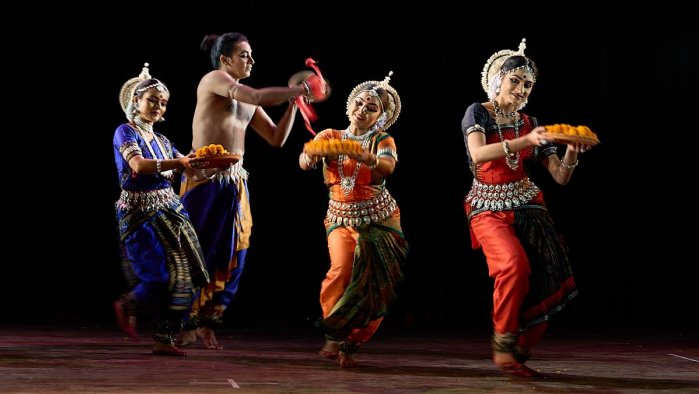 Mangalacharan 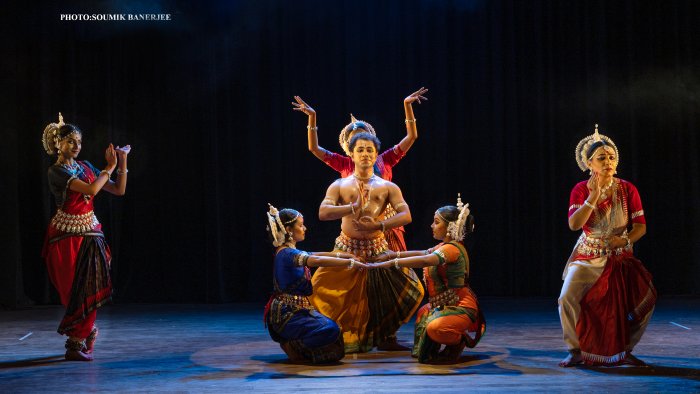 Dasavatar (Photo: Soumik Banerjee) Ritualistic inauguration and invocation with Pushpanjali followed by Jagannath Ashtakam as the Mangalacharan, by a group of skilled dancers ushered in the evening. Rina Jana's choreography of this common number beginning with the recitation of the shloka "Kadachit kalinditata vipina sangitaka" was appealing for its linear arrangement in two rows, diagonally on the performance space, facing the five feet high flower-bedecked idol of Lord Jagannath on the front corner of the stage. And the disciples of Rina Jana responded proficiently to her choreography with a spirit of the required devotion. Always a delight to watch was the 'Dasavatar,' the piece that is a set of shlokas of the glorious celebration of the ten appellations of Lord Vishnu (Jai Jagadish Hare!) penned by Kavi Jayadev. The choreography by Rina Jana blended an array of compositions and dance traditions of her Guru with some of her own arrangements resulting in an exotic effect like the sculpturesque display of Lord Vishnu formed by the arms of two female dancers. The elaborate item set to raga Mohana, taal Ardha Jhampa showed some striking imagery of the Matysa Avatar with two female dancers depicting 'Fish', Vaman Avatar and of course the common grotesque Narasimha Avatar. 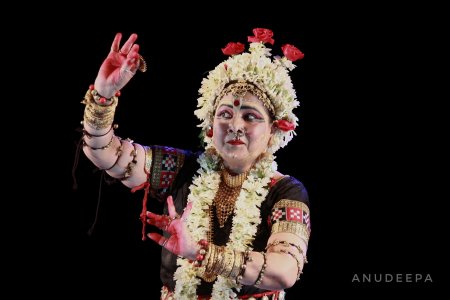 Rupasree Mohapatra (Photo: Anudeepa) A treat to the Kolkata audience came next in the form of Mahari Dance (or dance by Mahan nari or great women) by none other than the internationally renowned Rupasree Mohapatra, the first artiste to bring the dance form to the proscenium stage from the precincts of the temple for a solo and then a duet with her daughter Devarupa Dasgupta. In the temple of Lord Jagannath at Puri, dance and music were introduced as rituals since 12th century A.D. Devdasis or Maharis and percussionists (Madelis) have since then been appointed hereditarily. Trained for 34 years from the "nachoni maharis" or devadasis who serve and entertain Lord Jagannath with their typical stylistic dancing, Rupasree was fortunate to learn from the famous Maharis - Sashimoni, Parasmani, Harapriya and Kokila - all sebayats, sevadasis or devadasis of this tradition from the 'Srimandir' (temple). She has also been trained in classical Odissi that was reflected in her presentation, and is the only prominent teacher who teaches her art to students in her school 'Rupasree Kala Mandir' at Puri. At present she is engaged in teaching Ashtapadi at the Guruvayur Temple in Kerala. The dimly lighted stage reverberated with the chanting of "Viharati boney Radha" the first shloka of Canto 2, (Aklesha - Keshava, Keshava, The Blessed One) from Jayadeva's Gita Govinda, followed by the 5th prabandha (composition) "Sanchara dadhara". It portrayed Radha's pride that was badly hurt due to Hari's casual love for all women. Stung by envy, she wandered in the forest. In the sadness of her separation from Krishna, she opened her mind to her companion and ruminated the charm of Krishna during their earlier raasa leela. Gradually with the illumination, a heavily bejewelled and flower bedecked smiling dancer in a dazzling costume with twinkle in her eyes, appeared on stage with a short nritta piece accompanied by the music - continued performing in the Mahari style accompanied by one of Jayadeva's lovable lilting 3rd line of the prabandha, "Raase harimiha vihita vilasaam" from Gita Govinda. With her sensuous sways like the ebb and tides, coquettish smiles and emotional attitude of expressions, Rupasree brought alive the lyrics of the poetry where Radha in her imagination recalls Krishna's playful laughs, restless eyes, his alluring flute and swaying head during his pulsating dalliance of raasa, unfolding the power of dream. A mesmerising rendition where the interpretative focus was not overshadowed with the Odissi grammar. 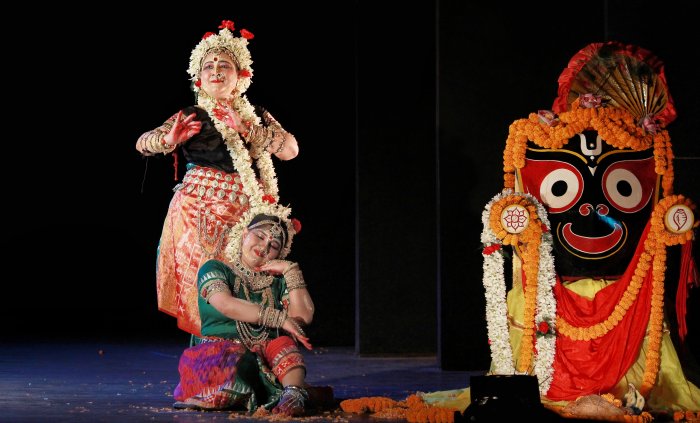 Rupasree Mohapatra & Devarupa Dasgupta The duet "Madhura bacchana kahanti Mohana" penned by poet Banamali, in which she combined beautifully with her equally competent daughter Devarupa Dasgupta was equally enchanting. Her rendition proved that the Mahari dance is safe in the hands of this young dancer. It was all about Krishna (Rupasree) giving an excuse to Radha (Devarupa) that he was coming to meet her last night but went off with Chandraboli. And Radha accusing him in anguish! The repetition of the line "Kishorije srimukho chahicchi..." at the end of every 4th line of the verse, with Rupasree caressing the face of her daughter as (Kishori-Radha) was a fine theatrical imagery, representing confession with passion. Their intimate face to face, back to back or side by side, romantic images were embellished with sukachanchu and hansasya mudra, plenty of chibuka mandana, bamachala and dakshyachala with a sprinkling of chauka from the Odissi tradition and was a duo work full of subtle emotions and poetic colour. The next to storm the stage was the young Chhau dancer Shubham Acharya, the eighth generation magical chip off the old block of the traditional family of Seraikella Chhau performers. Grandson of the acclaimed Lingaraj Acharya, the last Guru of the Purto Sahi Akhara, he since his childhood under the guidance of his father, the eminent Chhau performer and teacher, Guru Shashadhar Acharya, trained in the art and was also tutored by his uncles Sukanta Acharya and Sapan Acharya. He was a trainee in the project to spread the craft of Chhau dance under the Sangeet Natak Akademi and received the senior scholarship from the Ministry of Culture, Government of India, to specialize in the art. He has also been travelling with his father and their troupe to prestigious festivals in India and abroad. At present, Shubham is sharing his knowledge at various prestigious institutions like the National School of Drama, Film and Television Institute of India, Jamia Milia Islamia, Triveni Centre for Performing Arts and Sriram Centre for Performing Arts to name a few. 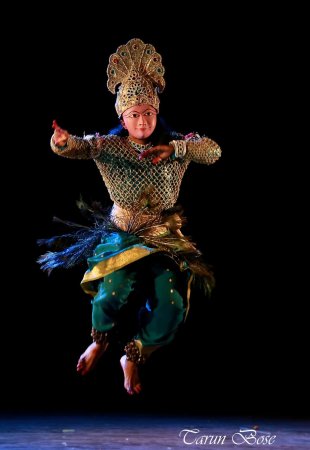 Shubham Acharya in 'Peacock' Shubham commenced with his showstopper performance "Peacock" set to raga Megh and Bahar in 8 matra, based on the soul-stirring composition "Hriday aamar nacherey ajikey mayurer moto nachey re" (Today my heart dances like a peacock) by Rabindranath Tagore from his monsoon section of songs/poems. The masked dancer entered with turns and steps governed by the rhythmic syllables of the nagara, dhol (cylindrical drum) and muhuri or shehnai and took a change in tempo with a rhythmic flourish (katan). He then moved elegantly with a choreographic pattern of characteristic body twists which is within a part of the Chhau framework. And Shubham moved with exactitude and mathematical precision, never to falter a step and landed pat on the stage. The peacock presented as his star production was highly stylised but the movements did not fully resemble that of the bird even though it was highly exuberant and delightful. To watch the startling contraction and release of the lower torso, the topkas (gait) the jumps or uflis and jerks of his masked head with the subtle accompaniment of the tune of the original Rabindrasangeet was a flavoursome experience that can be seen again and again. Sagar (Ocean), his next item was a sophisticated portrayal of the waves of the sea in raga Kirwani and 7 matra. The entry and his style at a glance were smooth, slow and gradual like a calm sea, and then swaying gently resembling the undulating waves. The beautiful shining satin sea-blue attire that highlighted the surroundings with the refrain of the symphony that articulated the phrases of the raga Kirwani enhanced the appeal of the dynamics of his movement. There was no vigour nor jerks in his masked body but a graceful, flexible performer aided by the innovatively designed flowing garment especially around the arms. The dancer marvelled the audience with his technical prowess and artistry of Chhau as well as elevations to picturise the crests and troughs in the sea, followed by encircling the stage with the vigorous torso movements of the Chhau featuring memorable and vivacious fascinating performances showing forceful turbulence. And thereafter tranquility featuring stillness in the sea water with the dancer in perfect relaxation with a final calm down. All the audience was left with was unexceptionally cherished moments of the way he used his body, wondrous but truly a sight to see! Two skilled senior dancers Sucheta Sarkar and Anisha Mondal from Krittika's ensemble took the stage next with a stunning duet of Shankarabharanam Pallavi in the Guru Pankaj Charan Das style - a style that is hardly seen being performed in the city. This particular duet set to raga Shankarabharanam had been taught to them by their teacher Rina Jana. The composition was sprinkled with lots of side-by-side sways, and bhramaris with gentle rotatory motion from the waist. And the graceful dancers showed their maturity in offering a spirited performance. With the sharp music of a muhuri (a reed instrument resembling that of tar-shehnai) and mardala, they entered occupying a diagonal position on the stage and later moved on to the centre - an uncommon strategy in presentation for a duet! Their synchronization and grip of rhythm was praiseworthy. Once again in recent times, a performance including dancing together, rotating back to back took one by surprise as it seemed to be a latest often incorporated movement input in any presentation! 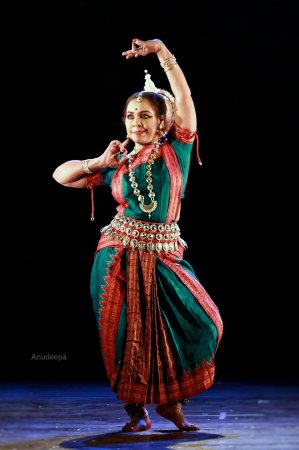 Kakali Bose (Photo: Anudeepa) Kakali Bose is a seasoned senior, widely performed and reputed dancer, trained with Poushali Mukherjee and later with Guru Kelucharan Mohapatra for ten years .She is at present the guest lecturer of dance at the Rabindra Bharati University, Kolkata and took the stage with her recital of a self-composed Desh Pallavi, in Ektal with music by Himangshu Swain. Showing meticulous approach to the grammar of Odissi, she presented a fresh approach to the often seen Desh Pallavi by offering an openness to the movement of the position of the arms keeping the basic hasta mudras intact while entering and then with angularity of the upper torso, stretched fluid hand and eye movements, projecting an artistic composition that creatively explored the intricacy of the rhythm with her elite training and experience. Kakali's abhinaya piece set to raga Pahari and taal Joti, was the 6th Ashtapadi of Canto 2 where Radha recounts her amorous union with Krishna in the past to her sakhi. The popular Ashtapadi "Sakhi hey kesi mathanamudaram" began with "Nribhritanikunjagrihagataya nishi rahasi nilaya vasantam" where Radha tells her sakhi that on coming to the lovely forest hut at night she was looking around in awe thinking about Krishna's charm. She pleads to her sakhi to arrange a love dalliance for her (Radha) with the killer of the horse demon Kesi. The sublimity and intense facial expressions of the dancer revealed her attention not only to details but also to her perfection and devotion to her artistry. Her performances, mostly demonstrative in pure dance numbers, had precise lines and impressive moments like seeing the mirror, playing the sitar and plaiting her hair, highlighting the metrical beauty of the text and offered a quick rapport with the audience. Composed by Guru Kelucharan Mohapatra the lively number "Nachanti rangrey Srihari" penned by poet Banamali was a vibrant solo by Rina's disciple Sanjay Shaw. A very well-trained and skilled dancer, Sanjay made his mark with his clarity of movements replete with tandava elements, an almost perfect tribhanga and strong footwork with varied sanchari bhavas. Here is a dancer who has brought this old gem to the stage retaining its original impact. 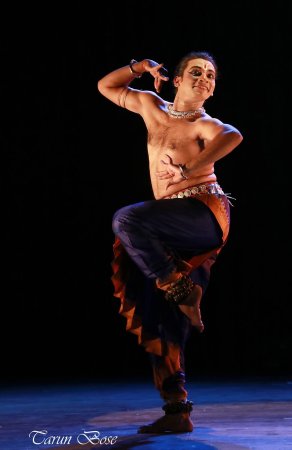 Sanjay Shaw 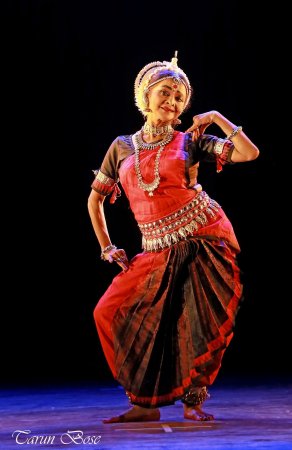 Rina Jana The evening concluded with the much awaited performance by one of the finest dancers, Rina Jana. Rina knows the grammar of Odissi inside and out and so her pure dance item "Simhendra Madhyam Pallavi" like some of her other memorable nritta numbers, especially Jugmadanda and Desh Pallavi, was outstanding. The well-crafted seldom performed intricate Pallavi set to Ektali was composed by Guru Kelucharan Mohapatra set to music by Pt Bhubaneswar Mishra. Rina Jana's execution spelt out the distinctive splendours of the special composition that was a bouquet of complex designs in the Odissi idiom, with her strong angularity of the hastas and body inflexions, especially the bhramaris with the rotatory movement of her lower torso, while preserving the mathematical precision in the series of prescribed movements. The dancer executed them with vigour as well as tenderness in perfect coordination of motifs and postures both aesthetic and technical with tremendous poise. While the stunning recital was approaching the conclusion with the pose of Krishna, with the solitary refrain of the flute, the dancer remaining at a static position in a perfect tribhanga with sculptural grace, the power suddenly got disconnected, lights on the stage went off and there was complete darkness for a split second only to be illuminated by a spotlight on the dancer who was on her knees with her hands widely spread out above as if pleading to the Almighty. Rina appeared to be in trance, in a state of devastating devotion - Samarpan - complete surrender to god. The hypnotic effect took the audience by surprise as it was later known to be impromptu not pre-planned, yet dramatic. Rina, a matured dancer gained composure to bring Pravaha 2025 to a ritualistic conclusion with her students with "Sarvamangala Mangalye Shivey..." the customary 'Moksha' for an Odissi dance recital. The artistes in the group items apart from those already mentioned were Subinita Mukherjee, Piyali Das, Subhadeepa De, Nita Das, Arindam Giri and Mala Sinha. The program was efficiently anchored by Aklanta Majumdar. 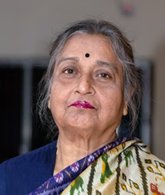 Dr. Nita Vidyarthi is a veteran critic of performing arts and writes on dance, music and theatre in leading publications. |